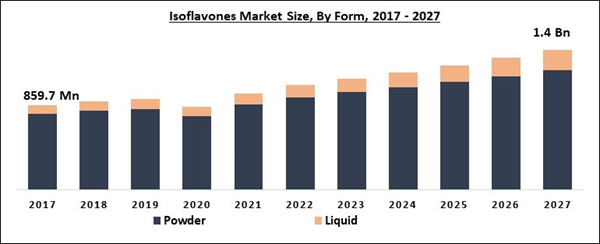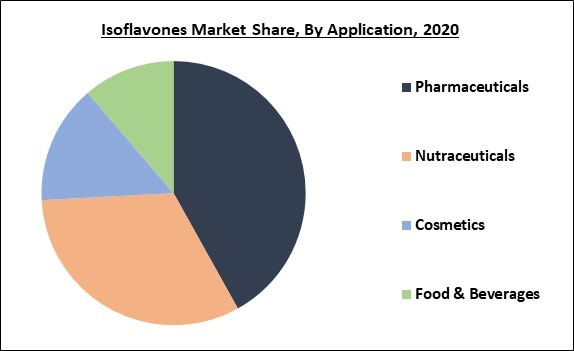The Global Isoflavones Market size is expected to reach $1.4 billion by 2027, rising at a market growth of 6.4% CAGR during the forecast period. Isoflavones refer to the polyphenolic compounds that show estrogen-antagonist and estrogen-agonist characteristics. Glycitein, genistein, and daidzein are the most active isoflavones available in soybeans and that are also the phytoestrogens with robust estrogenic activity. Various clinical studies have shown that genistein and daidzein are extremely helpful to prevent prostate and breast cancer, osteoporosis, and cardiovascular diseases and provide relief in postmenopausal symptoms.
The isoflavones market is expected to witness lucrative growth opportunities due to the rise in awareness about the health advantages of isoflavones along with the growing geriatric population. Moreover, the global market is expected to be fueled by the rising number of working women and an increase in the purchasing power of consumers for healthy food products.
Furthermore, the growth of the market is expected to be augmented by the increasing demand for nutraceutical supplements across every age group along with the rising disposable income of the global population. Geriatrics has been the global trend in well-established as well emerging countries. Consumers around the world are getting concerned about the changes in their quality of life and are closely monitoring their food habits. The consumption of infant formula having flavonoids has been fueled due to the growing number of working mothers around the globe, thereby boosting the demand & growth of the isoflavones in the market.
COVID-19 Impact Analysis
The outbreak of the COVID-19 pandemic has had a significant impact on the isoflavones market. Isoflavones find wide-range applications in various products such as nutraceuticals, dietary supplements, and pharmaceuticals. Isoflavones-based products are beneficial in enhancing muscle mass and immunity. Due to this aspect, the demand for isoflavones products has been increased in the last couple of years.
The demand for isoflavones among consumers has been fueled due to the increase in health concerns and higher consumer awareness, hence leading to the huge demand for fortified foods. Along with the available medical health supplements, consumers are highly inclined towards isoflavones dietary supplements as they are made from plants. The awareness of the consumers regarding the consumption of a healthy diet and supplements has been boosted due to the outbreak of the COVID-19 pandemic. Most of the dietary supplements and nutraceuticals products comprise isoflavones that are helpful in boosting gut health. Therefore, the outbreak of the COVID-19 pandemic has significantly affected the growth of the isoflavones market.
Market Growth Factors:
The market is set to fuel due to high occurrences of menopausal issues
Women at the menopause phase face different kinds of problems like insomnia, hot flashes, and in many instances, sexual dysfunction. Most of the women are tend to purchase supplements that have estrogen that could substantially increase the possibility of blood clots, breast, stroke, or uterine cancer. Therefore, estrogen is not the feasible choice for most of women due to their health and family health history.
The advent of latest technologies
The utilization of nanotechnology for the synthesis of APIs is one of the new improvements in drug developments. The advent of nanoparticle technologies for the delivery of APIs effectively displays its high potential as an innovative and effective approach. Nanobodies are the same as single-domain antibodies that can be fixed to particular antigens; though, they are lesser in size in comparison to antibodies.
Market Restraining Factor:
Isoflavones are less effective in comparison to the counterparts
Soy isoflavones can take various weeks or more to reach their market advantages. For instance, according to Healthline Media (US), a 2015 study revealed that soy isoflavones take above 13 weeks to reach just half of their highest effect. Conventional hormones like estrogen therapy; however, take approximately three weeks to display the same kinds of advantages.
Form Outlook
Based on Form, the market is segmented into Powder and liquid. The powder segment procured the maximum revenue share of the global isoflavones market in 2020. This is due to trends prevailing in the isoflavones market like easy handling and usage of isoflavones in various nutraceutical and pharmaceutical applications.
Application Outlook
Based on Application, the market is segmented into Pharmaceuticals, Nutraceuticals, Cosmetics and Food & Beverages. The pharmaceuticals segment is expected to acquire the maximum revenue share throughout the forecasting period. This is due to the increasing application of isoflavones because of their therapeutic and functional properties.
Source Outlook
Based on Source, the market is segmented into Red Clover, Soy and Other Sources. Isoflavones are extracted from peas, soybeans, red clover, and other natural sources. Soy-based extracts obtained the highest revenue share of the global market in 2020. Moreover, the segment is likely to exhibit a similar kind of trend during the forecast period. Other sources like lentils, red clover, peas, beans, green tea, and flaxseeds acquired a moderate revenue share of the global isoflavones market in 2020. Numerous research organizations that do the extraction process are striving to create the latest and advanced methods for extracting the isoflavones from their sources.
Regional Outlook
Based on Regions, the market is segmented into North America, Europe, Asia Pacific, and Latin America, Middle East & Africa. Asia-Pacific is one of the leading regions of the global isoflavones market. Some of the major countries of the region are India, China, Japan, and South Korea that are also the biggest consumers of soy and its products in the world. As a result, the demand for isoflavones is not very high in such countries. The demand for the product in Asian economies is quite less in comparison to the western countries due to the high consumption of beans, soy, peas, and other sources in their daily diet. Moreover, a significant portion of the population is suffering from breast cancer and other diseases, hence bolstering the demand of isoflavones in the regional market.
The market research report covers the analysis of key stake holders of the market. Key companies profiled in the report include Archer Daniels Midland Company, BASF SE, Koninklijke DSM N.V., International Flavors & Fragrances, Inc. (DuPont Nutrition), Shanghai Freemen, LLC, Nexira, Inc., Hyundai Bioland, Tradichem S.L., FutureCeuticals, Inc. (R. J. Van Drunen & Sons, Inc.), and Lactonova Nutripharm Pvt. Ltd.
Recent Strategies Deployed in Isoflavones Market
- Aug-2020: BASF unveiled Xitavo Brand soybean seed with Enlist E3 technology in the US. This new seed is expected to help the soybean cultivators in terms of having more choice and flexibility in choosing herbicide tolerance traits, genetics, BASF seed treatments, and crop protection solutions.
- Feb-2020: ADM expanded the production of its existing product viz. non-GMO soy protein concentrate at its facility in Europoort, Netherlands. This manufacturing unit manufactured non-GMO soy protein concentrate that is available in the form of powder and is expected to be appropriate for every kind of food application.
- Sep-2019: Frutarom Health, a division of International Flavors & Fragrances, rolled out a new range of Organic SoyLife Complex soy isoflavones. The product is manufactured with the help of non-GMO, organically-grown soybeans cultivated for conventional food production.
- Dec-2018: BASF introduced Obvius Plus fungicide seed treatment and Vault IP Plus seed treatment. Through this launch, the company expanded its soybean seed treatment portfolio and provide soybean cultivators with a wider product offering.
- Aug-2018: BASF rolled out Credenz soybean with LibertyLink GT27, the first of its kind soybean seed technology having herbicide-tolerant stacked traits. The technology is expected to help the cultivators to apply both Liberty herbicide and glyphosate on the top of soybeans for post-emergence control of broadleaf and grass weeds.
- Feb-2018: Archer Daniels Midland formed a joint venture with Cargill named SoyVen. This joint venture aimed to offer soybean meal and oil for customers in Egypt.
- Jan-2018: ADM expanded its geographical reach by establishing an innovation center in Singapore. The new facility is expected to promote the ingredient development and the application of food, industrial, feed, and energy products.
Scope of the Study
Market Segments Covered in the Report:
By Form
- Powder
- Liquid
By Application
- Pharmaceuticals
- Nutraceuticals
- Cosmetics
- Food & Beverages
By Source
- Red Clover
- Soy
- Other Sources
By Geography
- North America
- US
- Canada
- Mexico
- Rest of North America
- Europe
- Germany
- UK
- France
- Russia
- Spain
- Italy
- Rest of Europe
- Asia Pacific
- China
- Japan
- India
- South Korea
- Singapore
- Malaysia
- Rest of Asia Pacific
- LAMEA
- Brazil
- Argentina
- UAE
- Saudi Arabia
- South Africa
- Nigeria
- Rest of LAMEA
Key Market Players
List of Companies Profiled in the Report:
- Archer Daniels Midland Company
- BASF SE
- Koninklijke DSM N.V.
- International Flavors & Fragrances, Inc. (DuPont Nutrition)
- Shanghai Freemen, LLC
- Nexira, Inc.
- Hyundai Bioland
- Tradichem S.L.
- FutureCeuticals, Inc. (R. J. Van Drunen & Sons, Inc.)
- Lactonova Nutripharm Pvt. Ltd.
Unique Offerings from the Publisher
- Exhaustive coverage
- The highest number of market tables and figures
- Subscription-based model available
- Guaranteed best price
- Assured post sales research support with 10% customization free
Table of Contents
Companies Mentioned
- Archer Daniels Midland Company
- BASF SE
- Koninklijke DSM N.V.
- International Flavors & Fragrances, Inc. (DuPont Nutrition)
- Shanghai Freemen, LLC
- Nexira, Inc.
- Hyundai Bioland
- Tradichem S.L.
- FutureCeuticals, Inc. (R. J. Van Drunen & Sons, Inc.)
- Lactonova Nutripharm Pvt. Ltd.
Methodology

LOADING...










